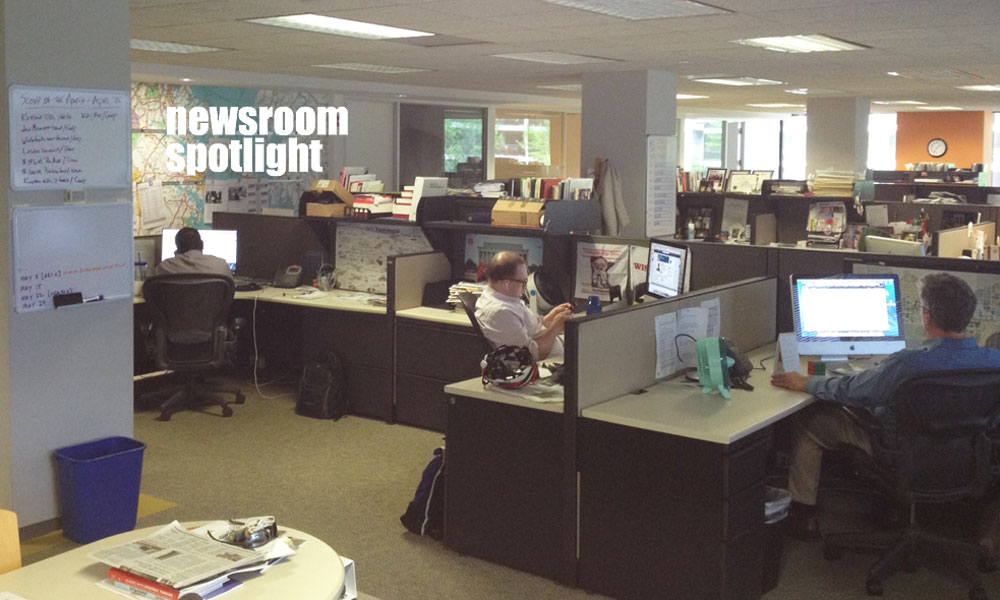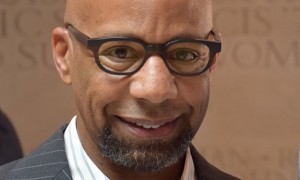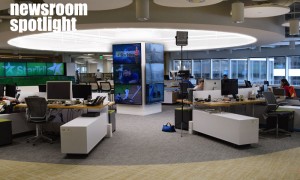
Editor’s Note: This Q&A is part of “Newsroom Spotlight,” a series of conversations with journalists about what’s going on in their newsrooms and the media industry. The interview excerpts have been lightly edited and organized for clarity.
Robert Terry knows a thing or two about change, within the context of business, technology and journalism.
For the past 20 years, he has covered business and technology from Baltimore to Washington, serving for the past four years as managing editor of Washington Business Journal. He oversees a newsroom of about 18, including assistant managing editors for print and video, plus digital producers, reporters and other specialists.
His staff produces five newsletters a day, specifically morning and afternoon roundups, plus niche reports for technology, real estate and government contracting. But newsletters are only one way of reaching Beltway business leaders. He and his team, along with WBJ’s audience development director, are constantly experimenting with the best time to deliver newsletters, tweets, videos and fresh posts.
The average consumer, according to the online media kit based on 2014 research, is a highly educated male who favors the late-afternoon newsletter; about a third of its online audience visits the WBJ website daily.
WBJ is part of Business Journals, a division of American City Business Journals, based in Charlotte, N.C.
American Journalism Review: Tell us about your newsroom operation.
Robert Terry: We probably produce 30 to 40 pieces of content for our website [a day]. That is everything from a quick hit, to a two-paragraph aggregation to multiple-source reporting. The news of the day can be anywhere from 30 to sometimes 50 pieces of content a day starting from as early as 5:30 in the morning through 8 at night. A lot of our content is being pushed out on our social channels. We have a Facebook page, a Twitter account, we have a LinkedIn page, Google Plus page. Most of our social distribution is through Facebook and Twitter.
AJR: What key experiments are currently underway in your newsroom?
Terry: We are trying new things pretty much all the time in terms of what we cover and how we cover it, and how we can reach our audience as soon as possible. I think that’s a very general sounding answer, but it is the truth. We are experimenting all the time with social strategies.
AJR: What would be an example of a social strategy?
Terry: Oh, things like timing of posts on Twitter, or what kind of posts on Facebook seem to get shared and play well with a bigger audience. How often should we use photos on Twitter or Facebook posts? We were just talking the other day about how if you’re simply pushing out links to stories on Twitter you are not going to get a lot of engagement… There are some other things you are going to have to do to engage with your audience there, because you could have a post, that according to Twitter analytics, maybe could reach 1,000 people, but only 2.5 percent of them are even actually clicking on the link. So how do you build your brand as an expert business journalism [team] in D.C., and build your audience on that platform? There are different ways to experiment with that. Again, these are conversations that happen all the time all day…because the Internet is always changing.
AJR: You say you are analyzing “what works.” What is the metric of success?
Terry: We look at page views, we look at unique visitors, we look at percentage of our traffic that’s referred through social channels. We use a tool called Chartbeat. It gives you a real time look about how stories are doing on the web. That’s a really good tool. Our meat-and-potato analytics is a platform called Omniture … which gives us a break down of everything from page views to analytics to social referral, to track our video views. It can break down content by industry sector. In other words, what percentage of our traffic is from real estate stories versus healthcare stories.
AJR: How does your newsroom approach packaging stories for the web? What has your newsroom done in the past year to promote or re-organize archival content online?
Terry: It depends on the story. One thing we talk about is iterative reporting. If we don’t have the multiple source 500-word story ready, sometimes that’s OK. We can get the 250-word portion of that story out to our audience if it’s journalistically responsible. So we report iteratively when appropriate, which means we have one crack at a story, come back a couple hours later with a second bite at the apple, come back even a third time if we need to. The point is to be constantly broadcasting for our audience. So that’s something we emphasize with reporters. Now if the story needs more sources or more reporting, or if it’s just not ready for primetime, then we won’t deliver it. And we won’t go iterative. But that is something we talk about with digital.
We have some nice tools at our disposal as well in terms of content and packaging of contents – galleries and slideshows. We play around with video. So if we have an interview with a significant news anchor in the business maybe we can pull out the snippet of the conversation into a video, because that along with the story, we can get readers some copy.
AJR: What about archival content?
Terry: Reporters are always linking back to their work, or their colleagues’ work or competitor’s work. The link is such a valuable part of the digital news ecosystem. We’ve got to use them. Readers like them, appreciate them. Also, in terms of packaging, we have some tools in our content management system that enable us to display our archive work a bit differently and prominently in a way we hope interests readers.
AJR: Let’s talk mobile. How is your newsroom is approaching storytelling for mobile devices?
Terry: In a general sense we talk in the newsroom about the increasing numbers of our readers who are consuming our content on mobile devices. So we say to them things like a 1,000-word story isn’t going to play well on mobile. People are standing, waiting for a Metro, scrolling on their smartphone. So if you have a piece of news you must get in/get out as quickly, as effectively, as you can. It takes a lot of time to tell stories on a mobile platform. In a topical sense – and then in our content management system we have to craft a mobile headline versus a headline on the regular web. Mobile is becoming something increasingly emphasized. More and more of our audiences are finding us through mobile.
AJR: Which media companies do you think are disrupting your news media landscape?
Terry: A website like Business Insider. Quartz I think is doing some really great stuff. Even an outlet like BuzzFeed, which isn’t necessarily a business site, but they’re really, really innovative. And then our local competitors. They are all doing things that are disruptive, but we are trying to keep an eye on [them].
AJR: Describe the most innovative thing your newsroom has done in the past year.
Terry: I don’t know if I can put my finger on this one thing. What has constantly evolved is to be a digital-first newsroom. That is on the top of my innovation scale. How do we do that better? How do we do digital content? How can we be a digital-first organization and also add value in a different sort of news-consumption style with our product…One area where we are innovative is not necessarily about breaking news everyday. Business newsrooms are doing more and more events these days, bringing leaders together, to both network and hopefully provide content for an event platform and post them and give them stuff to think about. So we are doing a lot of innovative things in the newsroom.
AJR: What emerging technologies or storytelling methods are you trying to learn more about because they have the potential to impact news?
Terry: Definitely video is something we are trying to learn more about. There is such great potential there. And there are all these tools coming to produce video. It used to be we had to shoot it with a camera, and then edit it on Final Cut – I can’t work Final Cut [laughter] – whereas nowadays there are apps. You can shoot a video, and press a couple buttons in an app and boom it’s on your website. So it’s really exciting, and there’s a growing audience there. Personally, I am intrigued as well by certain long-form storytelling tools for journalism. How a longer kind of magazine-like story is presented on the web can really grab and hold readers. I am very intrigued by that.
AJR: How does your newsroom use analytics to make daily coverage decisions?
Terry: The first thing I do everyday is look at the report from day before to see what stories do really well and what stories didn’t. … And then from there, is there anything we need to jump on in terms of coverage? Reporters are constantly juggling various stories that they are chasing. Often, we sit down and say, “Well OK, this one story here, we did a similar piece two months ago, [and] it didn’t really reach a large audience.” So we put that down on a list of priorities, and bump these other two things up because we feel like we have a larger audience out there. We are constantly using Omniture and Chartbeat. We are constantly looking at Twitter analytics and how our emails are engaging to determine what we cover, how we cover it and how we package it.
AJR: Tell us about your newsroom’s social media efforts. Are all reporters required to use social media to promote their stories?
Terry: Yes. Got to be out there, engaging with audiences. And like I said earlier, not just pushing out links to their stories. Everything from engaging with readers who are out there to sharing a piece of news somebody else has that an audience might find interesting or helpful. It’s part of the job. For a reporter it’s really no different from a notepad and pen.
AJR: What are your most successful efforts involving obtaining user-generated content for your website?
Terry: Story tips from breaking news. We did a feature back in December in which we asked readers to share pictures of their office space with us – basically the question was, if you got a cool office, prove it to us. People sent us photos and captions, trying to tell a story of how their office is cool – this is a big thing at businesses – it is a good way to recruit social tool use. So we put everything together in some galleries. Readers couldn’t get enough of that. So that is one way we took a user-generated approach. I mean, we just don’t have a team of photographers that could have gone out and photographed all of these offices.








